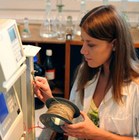












































 The Institute of Physical Chemistry PAS developed a new method of chemical analysis
The Institute of Physical Chemistry PAS developed a new method of chemical analysisNew, simple method for the analysis of balance of chemical reactions in solutions was developed at the Institute of Physical Chemistry. It can be used, for example, in chemistry, molecular biology, pharmacy and medicine.
"Presently, the doctor gives the patient a drug first, and then carries out the blood analysis. If anything is wrong, he changes the dose, and checks again until he finds the right dose. With our method it will be possible to draw few millilitres of blood before starting the treatment and determine how strongly the blood binds each medicine" - described by D.Eng. Anna Bielejewska of the Institute of Physical Chemistry.
Single analysis with this method takes approximately half an hour. After this time, appropriate software would provide a result with a dose tailored to the specific characteristics of particular patient’s organism.
The measurement uses very simple physical phenomena and consists in examining how the solution of two compounds flows through a long, thin tube - capillary.
According to the Institute of Physical Chemistry representatives, every angler knows that rivers floe fastest in the middle of the stream, while by the banks the current is always slower. Liquid flowing through the capillary behaves in the same way. If the flow is free of turbulence (laminar), fluid layers closest to the centre of capillary flow faster than the layers near the walls. "We use this fact in our method. The key, however, are phenomena associated with diffusion" - explained D.Eng. Bielejewska.
Liquid molecules can move (diffuse) from layer flowing at one speed to another layer flowing at a different speed. After injecting the capillary filled with a solution of one substance with second substance, the rate of diffusion will depend on how strongly the compounds in both solutions react chemically with each other.
Whether the particles move between layers of fast or slowly, can be determined with a detector. On this basis, it is possible to determine the diffusion ratios and calculate the stability constant of the complex. "It determines whether the chemicals bind with each other or not, and if so, how permanently" - explained Bielejewska.
Device developed at the Institute of Physical Chemistry consists of a pump that ensures a stable liquid flow at a rate of 0.00 millilitres per minute, sample dispensing autosampler, detector of visible radiation and ultraviolet rays, and a small capillary with diameter 0.25 mm and length of 25 m wound on the roller.
Institute representatives assure that the results of measurements would correspond to data obtained with classical chromatographic methods (used to separate and study the composition of chemical compound mixtures) and the values quoted in world scientific literature.
"We developed a new, effective method for the analysis of balance of chemical reactions in solutions, which can be performed with cheap and simple measuring equipment. Whether the method will become popular, depends only on the industry" - said Prof. Robert Hołyst from the Institute of Physical Chemistry.
From: PAP